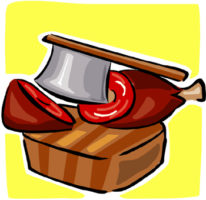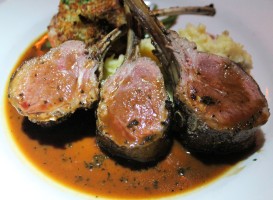 October 16, 2017
October 16, 2017
Days Until. . .
Halloween: 15 Thanksgiving (Nov. 23): 38
Restaurant Birthdays
Dickie Brennan's Bourbon House opened today in 2002. It was planned to be the seafood equivalent of Dickie Brennan's Steakhouse, just a half-block away. But it evolved into a general Creole restaurant, a touch on the casual side, with more than a few dishes originally made popular at Commander's Palace years before. The restaurant has an unusually large oyster bar, which is one of its finer points. There was a little controversy about its opening: Dickie's cousin Ralph Brennan, who already had a seafood restaurant at that intersection, was a little miffed at first. But both restaurants seem to be doing very well, so that's been forgotten. Today in 1997, Artesia opened in Abita Springs. The owner was Vicky Bayley, who also operated Mike's On The Avenue, on Lafayette Square. She wound up selling Mike's to Mike Ditka's, moving to Artesia and then--after a few more openings--returning to Mike's On The Avenue. Artesia is gone now, but it's worth remembering because it was where John Besh rose to national prominence. He went from there to open Restaurant August, the beginning of his now eight-restaurant empire. Vicky kept Artesia going for a few more years, then closed some months before Katrina. The delightful premises of Artesia--an old resort hotel--are still waiting for a new owner.
Food Calendar
The Food and Agriculture Organization of the United Nations celebrates World Food Day on this date every year. The observance calls attention to the need for greater research and investment in growing more and better food, for the millions who remain hungry around the world. Here's a web site with more about this.
Today's Flavor
It is also National Lamb Chops Day. Lamb chops were, at one time, on the menus of every kind of restaurant. Around the 1970s, they started moving upscale. Perhaps that's because lamb prices increased a lot. Or it may have been because the still-young Baby Boomers found lamb's flavor too assertive. When they grew up and their palates became more sophisticated, they found racks of lamb waiting for them on the white tablecloths, and rediscovered their goodness. The proliferation of Middle Eastern restaurants brought lamb chops back down to affordable prices, and people have resumed eating them at home.
 There are two principal varieties of lamb chops, with very different flavors and textures. The more common kind cut from the rib rack. This gives us the classic lamb chop, with a curved bone ending in a round eye of meat, surrounded by a good amount of fat. But the lamb T-bone is gaining in popularity. With a sirloin on one side of the bone and tenderloin on the other, it sounds wonderful and is far from bad. But it contains less fat and tends to be less tender. It's also harder to grill uniformly and a little troublesome to eat, because you have to dig the meat away from the disproportionately large bone. They're a bit less expensive, fortunately. It would allay some confusion if restaurants serving lamb T-bones called them that instead of lamb chops.
There's another divide among lamb chops: their origins. The smaller ones typically come from Australia and New Zealand, the world leaders in lamb husbandry. They're small because the animals they use are younger than the ones preferred in America. American lamb chops are about double the size of the Down Under variety, and have a better flavor, in my opinion.
There are two principal varieties of lamb chops, with very different flavors and textures. The more common kind cut from the rib rack. This gives us the classic lamb chop, with a curved bone ending in a round eye of meat, surrounded by a good amount of fat. But the lamb T-bone is gaining in popularity. With a sirloin on one side of the bone and tenderloin on the other, it sounds wonderful and is far from bad. But it contains less fat and tends to be less tender. It's also harder to grill uniformly and a little troublesome to eat, because you have to dig the meat away from the disproportionately large bone. They're a bit less expensive, fortunately. It would allay some confusion if restaurants serving lamb T-bones called them that instead of lamb chops.
There's another divide among lamb chops: their origins. The smaller ones typically come from Australia and New Zealand, the world leaders in lamb husbandry. They're small because the animals they use are younger than the ones preferred in America. American lamb chops are about double the size of the Down Under variety, and have a better flavor, in my opinion.
 The best thing that happened to lamb chops in recent history is the obsolescence of mint jelly. That garnish may have been necessary when muttony, strong lamb was common, but it obliterates the flavor of good lamb. Many restaurants still serve it because some people expect it. But bearnaise sauce or a good lamb jus or demi-glace--perhaps with a touch of fresh mint in those sauces--are vastly better. They're also wonderful encrusted with black pepper. And the Lebanese practice of serving lamb with hummus as a sort of sauce is also complimentary to these delicious, special chops.
The best thing that happened to lamb chops in recent history is the obsolescence of mint jelly. That garnish may have been necessary when muttony, strong lamb was common, but it obliterates the flavor of good lamb. Many restaurants still serve it because some people expect it. But bearnaise sauce or a good lamb jus or demi-glace--perhaps with a touch of fresh mint in those sauces--are vastly better. They're also wonderful encrusted with black pepper. And the Lebanese practice of serving lamb with hummus as a sort of sauce is also complimentary to these delicious, special chops.
Gourmet Gazetteer
Burrito Creek is ten miles northeast of San Luis Obispo, California. It flows down the mountains of the Santa Lucia Wilderness, beginning at a spring at 1900 feet and descending three miles northeast to join Rinconada Creek on a flat, dry plain at 1200 feet. The water winds up in the Pacific by way of the Salinas River. There's an interesting place to eat three miles away from the mouth of Burrito Creek. The Rinconada Dairy raises sheep and makes cheeses of high quality with ewe's milk. You can spend a few days there, gathering your own eggs for breakfast and the like. Burrito Creek is named for a generic small donkey, not a Mexican wrap sandwich. .
Edible Dictionary
piccata, adj.--A pan-seared preparation of thin slices of veal, chicken, or other protein, served with a pan sauce of butter or olive oil with white wine and lemon juice. An almost universally-served dish in American Italian restaurants. Very similar to veal francesca. The word "piccata" is a reference to the old practice of jabbing the meat to work fat into it, to tenderize the often-tough veal. Since I mentioned that. . . Having to work some fat into a veal dish is necessary because a) veal is very low in fat, and 2) countermeasures are needed to keep the veal from becoming chewy and tough. That's ironic, because veal is usually chosen because of its alleged tenderness.
Deft Dining Rule #721
The minimum acceptable number of rib bones for an entree of lamb chops in a serious restaurant is three. If they're Australian or New Zealand chops, the number rises to six.
The Old Kitchen Sage Sez:
A lamb rack cooked whole and sliced after cooking will be tenderer and juicier than double--cut chops, and incomparably better than single chops.
The Saints
Today is the feast day of St. Gallo (also known as Gall and Gallinus), who was a missionary to the Alpine countries in the 600s. Perhaps because of his name (it means "rooster" in Latin), he is the patron saint of chickens and geese.
Annals Of Popular Cuisine
Tom Monaghan, the founder of Domino's Pizza, was born today in 1937. He started his ubiquitous take-out pizza business on a $500 loan and did pretty well--making decent if not fantastic pizzas. The conveyor-belt oven is the center of his operation, baking a pizza much faster but without the magical crispness of the crust. This is certainly true: Domino's is better than the convenience pizza of twenty or thirty years ago. But not nearly as good as a New York-style pizza made in a traditional stone oven.
Food In Show Biz
Today in 1941, the Will Bradley Band--whose best-known number was Beat Me, Daddy, Eight To The Bar--recorded a song called Fry Me, Cookie, With A Can Of Lard. Neither the song nor the dish caught on. . . Today in 1939, the comedy The Man Who Came To Dinner opened to huge success on Broadway, based on an incredibly obnoxious and pompous writer. Sounds familiar, somehow.
Food Through History
Today in 1793, Marie Antoinette--wife of King Louis XVI, already a victim of the French Revolution--was beheaded. The rabble quoted her alleged "let them eat cake" comment as evidence that she should be killed. (Actually, she suggested that, if they had no bread, the peasants should eat brioche--itself a kind of bread.) Thinking about that makes me think twice about telling people that they shouldn't eat frozen food.
Food In Science
Today is the birthday, in 1875, of Henry Sherman, an early researcher on nutrition. He made the first estimates of the ideal amounts of each of the vitamins we should consume daily. He also announced that spinach is not as enormously nutritious a food as Popeye says.
Food Namesakes
Missouri Congressman Alan Wheat was born today in 1951. . . R&B singer Sugar Pie DeSanto warbled her first notes today in 1935. . . Baseball Hall of Famer Goose Goslinstepped up to the plate of life today in 1900.
Words To Read Restaurant Reviews By
"Critics? I love every bone in their heads."--American playwright Eugene O’Neill, born today in 1888.
Words To Eat By
"But beef is rare within these oxless isles;
Goat's flesh there is, no doubt, and kid, and mutton;
And, when a holiday upon them smiles,
A joint upon their barbarous spits they put on."--Lord Byron.